Overview
The article titled "10 Essential Web Design Definitions for Tech Startups" seeks to address a common challenge faced by technology startups: the struggle to grasp key web design concepts. This understanding is not just a technical necessity; it’s a vital step towards building a strong online presence that fosters customer loyalty. Definitions such as user experience (UX), responsive design, and brand identity are more than just jargon; they are essential elements that can significantly impact a startup's growth and success in a competitive digital landscape. By embracing these concepts, startups can navigate the complexities of the digital world with confidence and clarity, ultimately paving the way for their success.
Introduction
Navigating the digital landscape can feel overwhelming for tech startups eager to carve out their online presence. With a myriad of terms and concepts to master, grasping the essentials of web design is not just beneficial—it’s essential for your success. This article explores ten vital web design definitions that illuminate the complexities of the digital world. More importantly, these insights empower startups like yours to enhance branding, improve user experience, and boost overall effectiveness.
How might these foundational concepts transform your budding tech venture into a memorable and trusted brand amidst the competition?
RNO1: Comprehensive Branding and Digital Design Services
For many technology newcomers, establishing a strong online presence can feel daunting. The challenge of navigating the digital landscape often leaves startups feeling lost and overwhelmed. It's not just about being seen; it's about being remembered and trusted. When startups invest in branding and digital creation services, they open the door to a world of possibilities. Research shows that maintaining brand consistency makes companies 3.5 times more likely to attract new customers, which is essential for building lasting relationships and fostering loyalty.
Imagine the relief of knowing that effective branding strategies can lead to revenue growth of 10-20%. This isn't just a statistic; it's a reality for 68% of businesses that have embraced brand consistency. Take Tesla, for instance. Their remarkable brand value surge is a testament to how tailored branding strategies can enhance customer loyalty and engagement. By sharing these success stories, we can inspire you to envision the potential for your own startup.
As we look toward the evolving landscape of 2025 and beyond, it's crucial to understand that the right support can make all the difference. RNO1 is here to guide you through this journey, offering expertise in branding identity development, online design, and performance marketing strategies. Together, we can create radical digital experiences that not only elevate your visibility but also position your business for sustainable growth. Let’s navigate this path together, ensuring that your startup not only survives but thrives in the digital world.
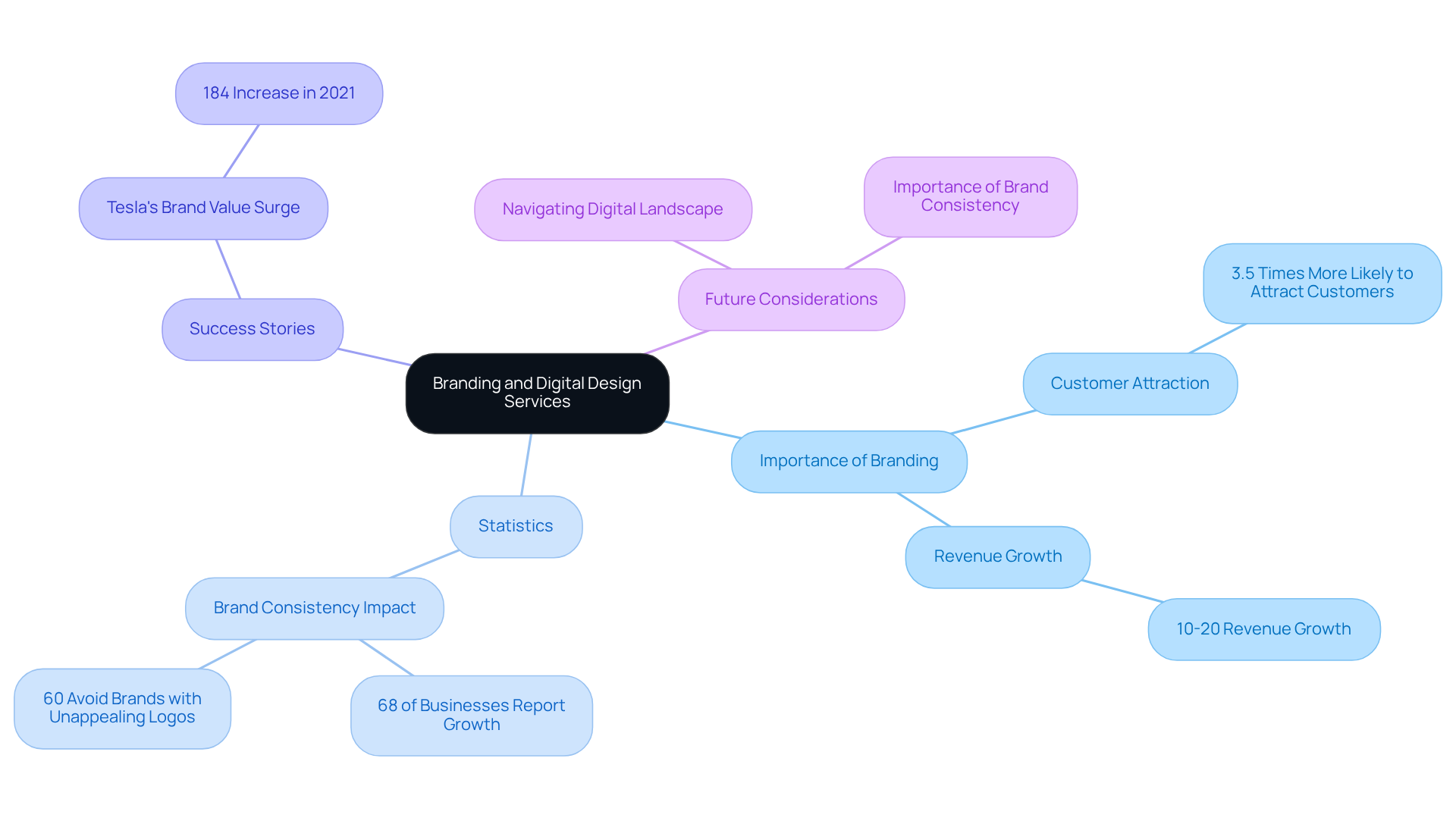
User Experience (UX): Enhancing Customer Interaction and Satisfaction
User Experience (UX) is more than just a technical term; it encompasses the overall interaction an individual has with a platform or application. For tech startups, this makes UX a pivotal factor in enhancing customer satisfaction and loyalty. When you prioritize effective UX design, you are not just improving a product; you are shaping perceptions and behaviors that can significantly impact your business.
Imagine the frustration of a potential customer navigating a confusing interface or waiting for a slow-loading page. This is a relatable problem that many startups face, and the consequences can be severe. Research shows that:
- 94% of first impressions are design-related, highlighting the necessity for a visually appealing interface.
- 88% of users are less likely to return to a website after experiencing poor user experience.
This is a painful reality that can hinder growth and repeat visits.
But there is hope. A well-optimized UX can lead to a remarkable 42% improvement in customer retention and a 33% increase in satisfaction. For new technology ventures, these factors not only promote loyalty but also greatly enhance conversion rates. Did you know that mobile sites loading in two seconds or less can achieve a 15% higher conversion rate? This underscores the urgency of optimizing loading times, as 53% of mobile site visitors leave if a page takes longer than three seconds to load.
By focusing on these essential aspects, startups can create engaging digital experiences that foster loyalty and drive growth. Take, for instance, the Staples UX-Focused Site Redesign, which led to an impressive 500% rise in online revenue. This case study exemplifies the substantial influence of effective user experience.
Let’s work together to ensure that your startup not only meets but exceeds the expectations of your users, creating a community that thrives on positive interactions and lasting relationships.
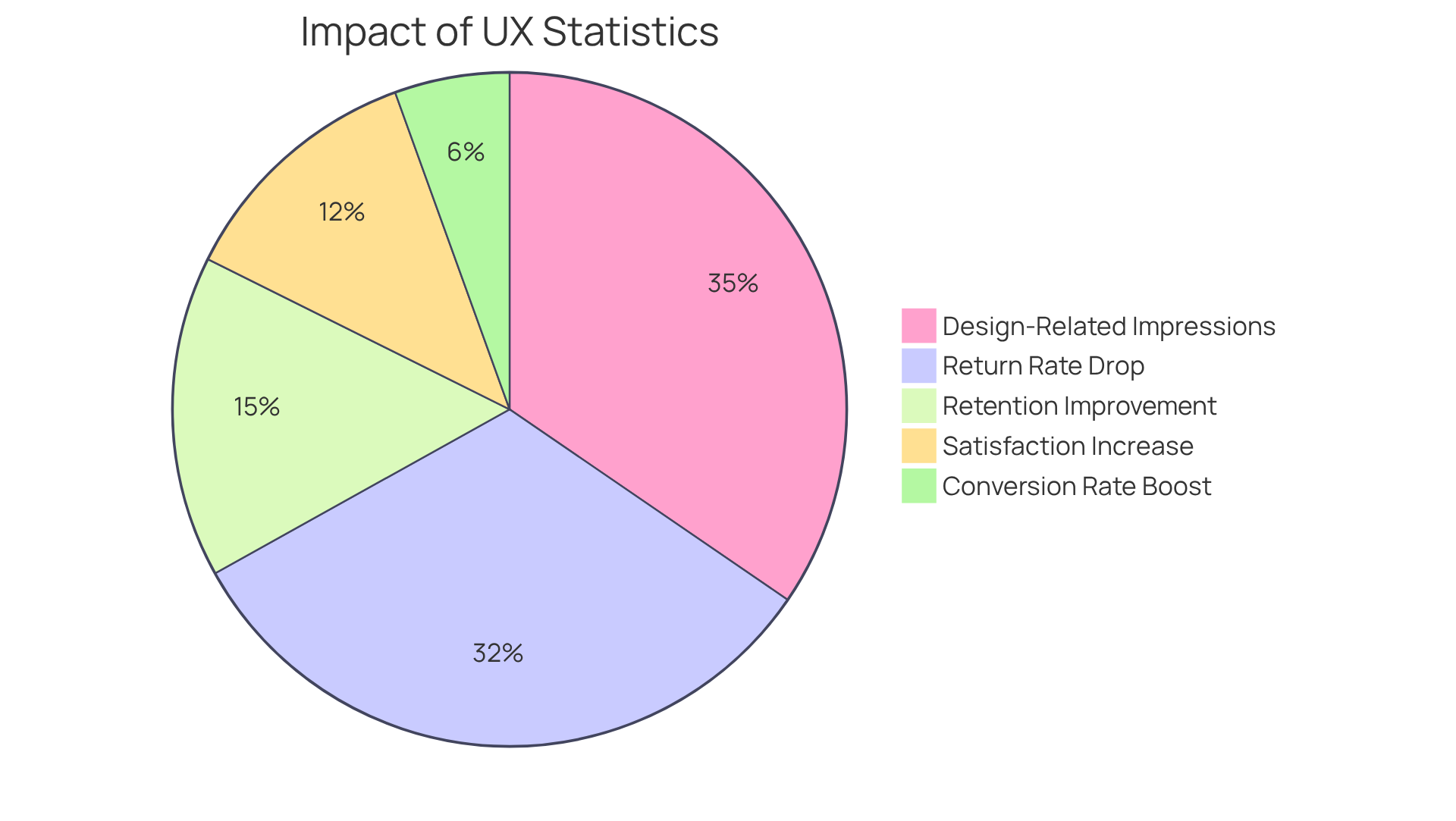
Responsive Design: Adapting to Multiple Devices for Optimal User Experience
Responsive layout is more than just a technical requirement; it’s a strategic approach that ensures your website's structure and content adapt seamlessly to various screen sizes and devices. For technology ventures, this is especially crucial, as mobile traffic represents a significant share of web visits.
Imagine this: 76% of US adults reported using smartphones for online shopping. This statistic highlights the necessity for mobile-friendly sites, and it’s a reality that many startup founders face. By implementing adaptive layouts, you can greatly enhance your visitors' experience. This not only leads to a 40% decrease in bounce rates but also nearly doubles mobile conversions.
This flexibility expands your audience reach and encourages greater engagement levels. People are naturally more inclined to interact with a site that operates effectively across all devices. However, it’s important to remember that 88% of online shoppers are less likely to revisit a site after a negative experience. This makes responsive design crucial for keeping your visitors and boosting conversions.
In a world where first impressions are formed in just 50 milliseconds, ensuring a seamless mobile experience is vital for technology companies like yours. It’s about establishing credibility and trust with your audience, and we’re here to support you in achieving that.
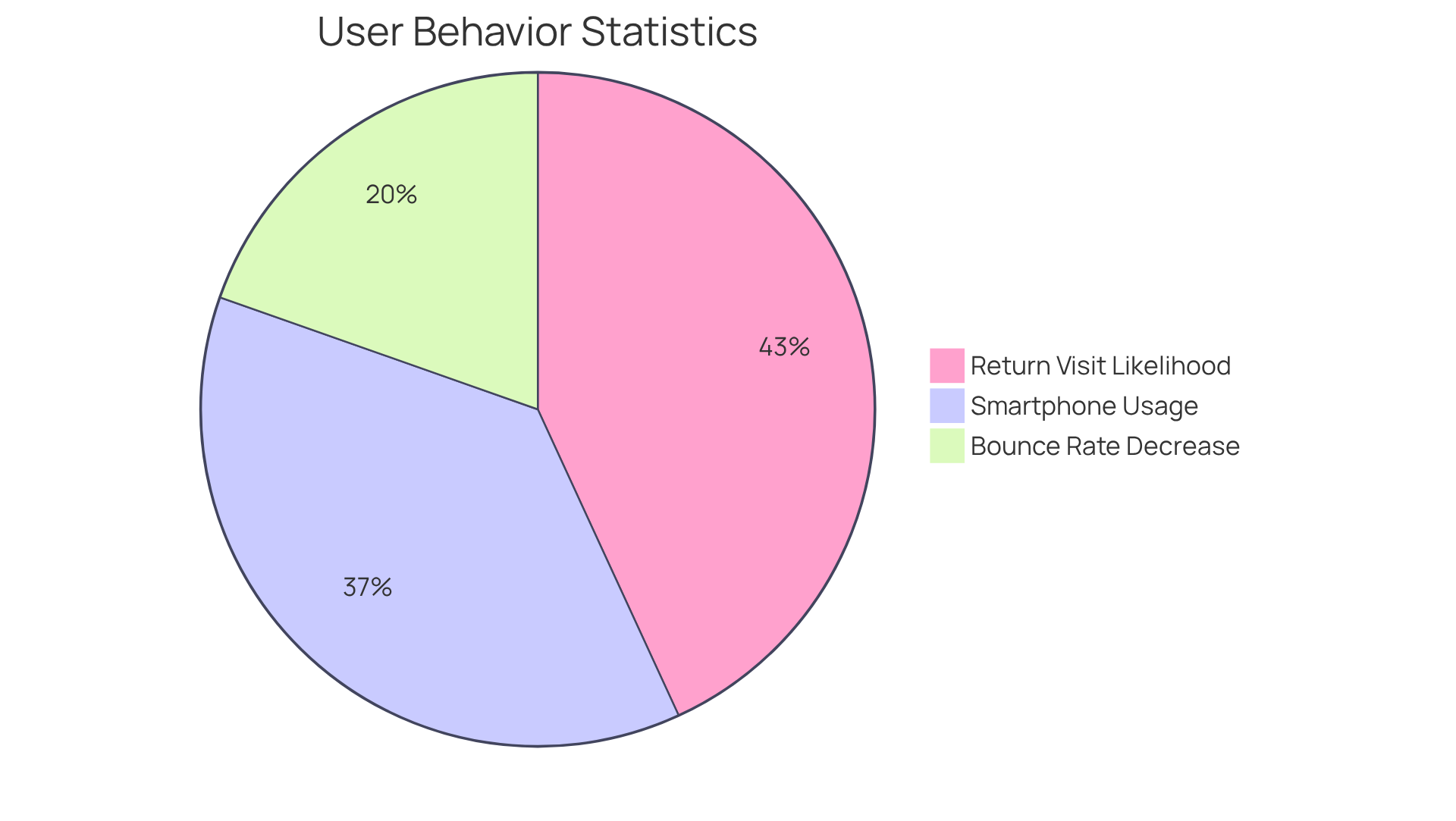
Content Management System (CMS): Streamlining Website Content Management
Navigating the digital landscape can be daunting for tech startup founders, especially when it comes to managing online content. Many struggle with the complexities of updating their websites and collaborating with their teams, often feeling overwhelmed by the technical demands. This can lead to frustration and hinder their ability to grow their online presence effectively.
Imagine the relief of having a reliable partner in this journey. A Content Management System (CMS) can be that ally, providing a user-friendly platform that allows you to create, manage, and modify content without needing specialized technical skills. With a strong CMS, you can simplify content updates, enhance collaboration among your team, and improve overall site management.
Consider popular options like WordPress and Shopify. These platforms not only offer intuitive interfaces but also empower new businesses to take control of their online presence. By embracing a CMS, you can focus more on your vision and less on the technical hurdles, knowing that support is just a click away. We're here to help you every step of the way, ensuring that your journey is as smooth and rewarding as possible.
Search Engine Optimization (SEO): Boosting Online Visibility and Traffic
Search Engine Optimization (SEO) is not just a technical necessity; it’s a vital process that enhances a website's visibility in search engine results pages (SERPs). For technology companies, the struggle to attract organic traffic can feel overwhelming, and the right SEO strategies can be a lifeline in boosting brand awareness. Imagine the frustration of low visibility in search results and ineffective content strategies. This was the reality for a collaboration between RNO1 and Four Words, a jewelry company. However, through nurturing partnership and strategic planning, they experienced a remarkable 142% increase in organic sessions and a jump in keyword rankings from 48 to 229. This transformation showcases the incredible power of a well-executed SEO strategy.
Prioritizing SEO offers more than just improved online visibility; it creates opportunities for new businesses to connect meaningfully with their target audience. Consider methods like:
- Enhancing website architecture
- Ensuring mobile compatibility—where a mobile-optimized site can achieve better rankings in search results
These adjustments not only enhance visitor experience but also foster increased engagement and conversion rates. Digital marketing professionals emphasize the importance of understanding customer search behavior through targeted keyword research, including the use of long-tail keywords. This understanding is essential for crafting relevant content that truly resonates with potential clients. By embracing these strategies, tech companies can build a strong digital footprint, paving the way for sustainable growth in an increasingly competitive landscape. Together, we can navigate these challenges and thrive.
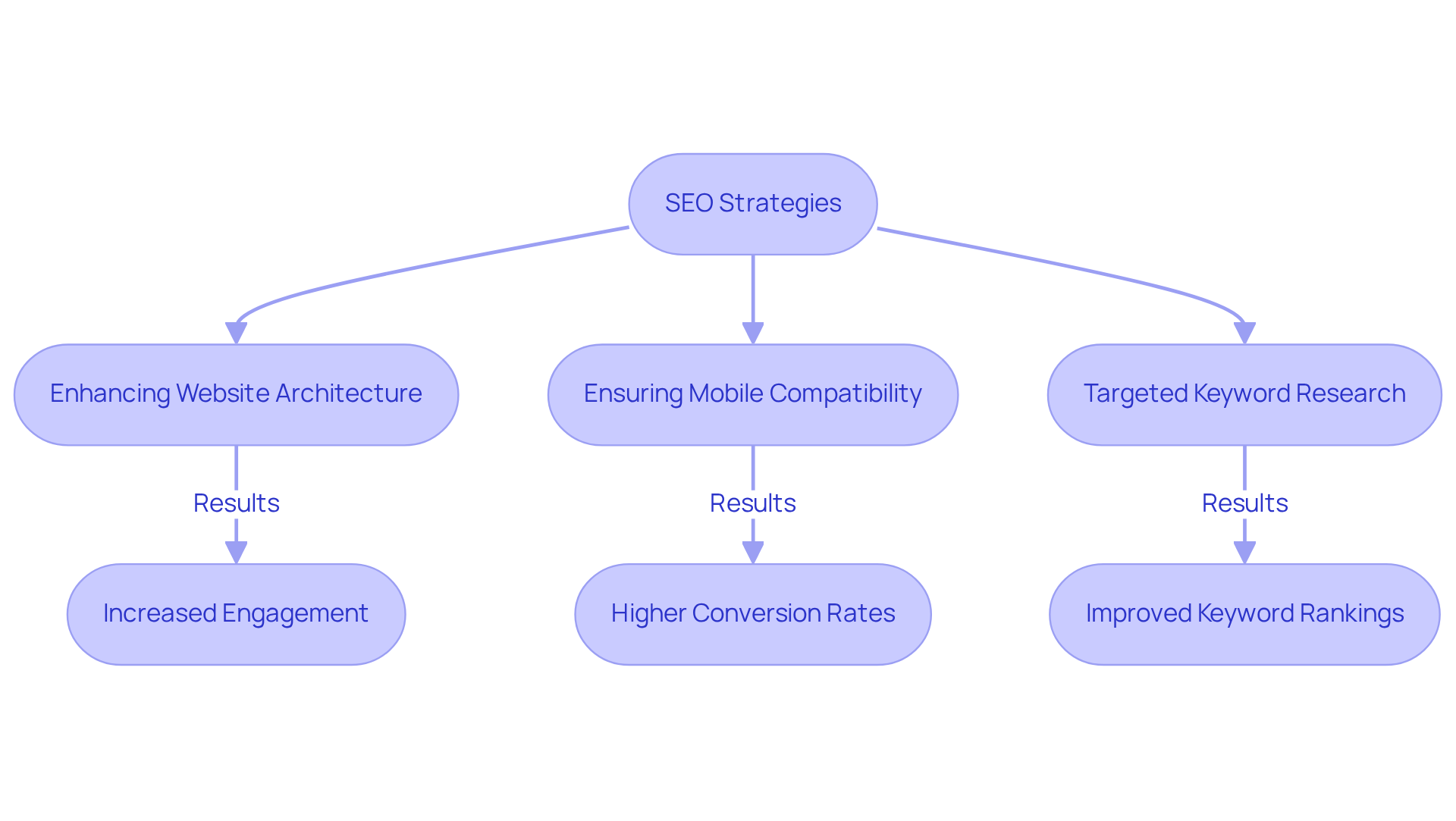
Call to Action (CTA): Encouraging User Engagement and Conversions
A Call to Action (CTA) serves as a vital prompt that encourages individuals to engage in specific actions, such as subscribing to a newsletter or making a purchase. For tech startups, the thoughtful positioning of CTAs across their websites can truly enhance audience engagement and conversion rates. Many founders may feel overwhelmed by the challenge of capturing attention, but research reveals that effective CTAs can boost conversions by over 160%. This highlights how crucial their arrangement and positioning can be.
To truly enhance effectiveness, CTAs must be clear, persuasive, and visually distinct, gently guiding individuals through their customer journey. Imagine the difference it could make—center-aligning CTAs can lead to over 680% more clicks compared to left-aligned options, underscoring the significance of layout in design. Additionally, integrating urgency signals, like 'Limited Time Offer,' can lead to an impressive 332% increase in conversion rates, tapping into the common fear of missing out (FOMO) that many experience.
Moreover, the impact of CTAs extends beyond mere clicks; they play a crucial role in fostering engagement. Personalized CTAs convert 202% better than generic versions, nurturing deeper connections with potential customers. This personalization, paired with strategic placement—such as positioning CTAs above the fold—can significantly enhance visibility and engagement, as these CTAs enjoy a 73% higher visibility rate than those placed below.
Consider also the power of simplicity: reducing the number of CTAs to just one per page can enhance conversions by 266%, streamlining the experience and focusing attention. Using action-oriented language can further increase conversions by 121% compared to passive wording, making the CTA feel more compelling and inviting.
In conclusion, it’s essential for technology ventures to prioritize the arrangement and positioning of CTAs to effectively boost engagement and conversions. By embracing clear messaging, strategic positioning, and personalization, new businesses can create inviting pathways for clients, ultimately leading to increased sales and lasting customer loyalty. Remember, you’re not alone in this journey; with the right approach, success is within reach.
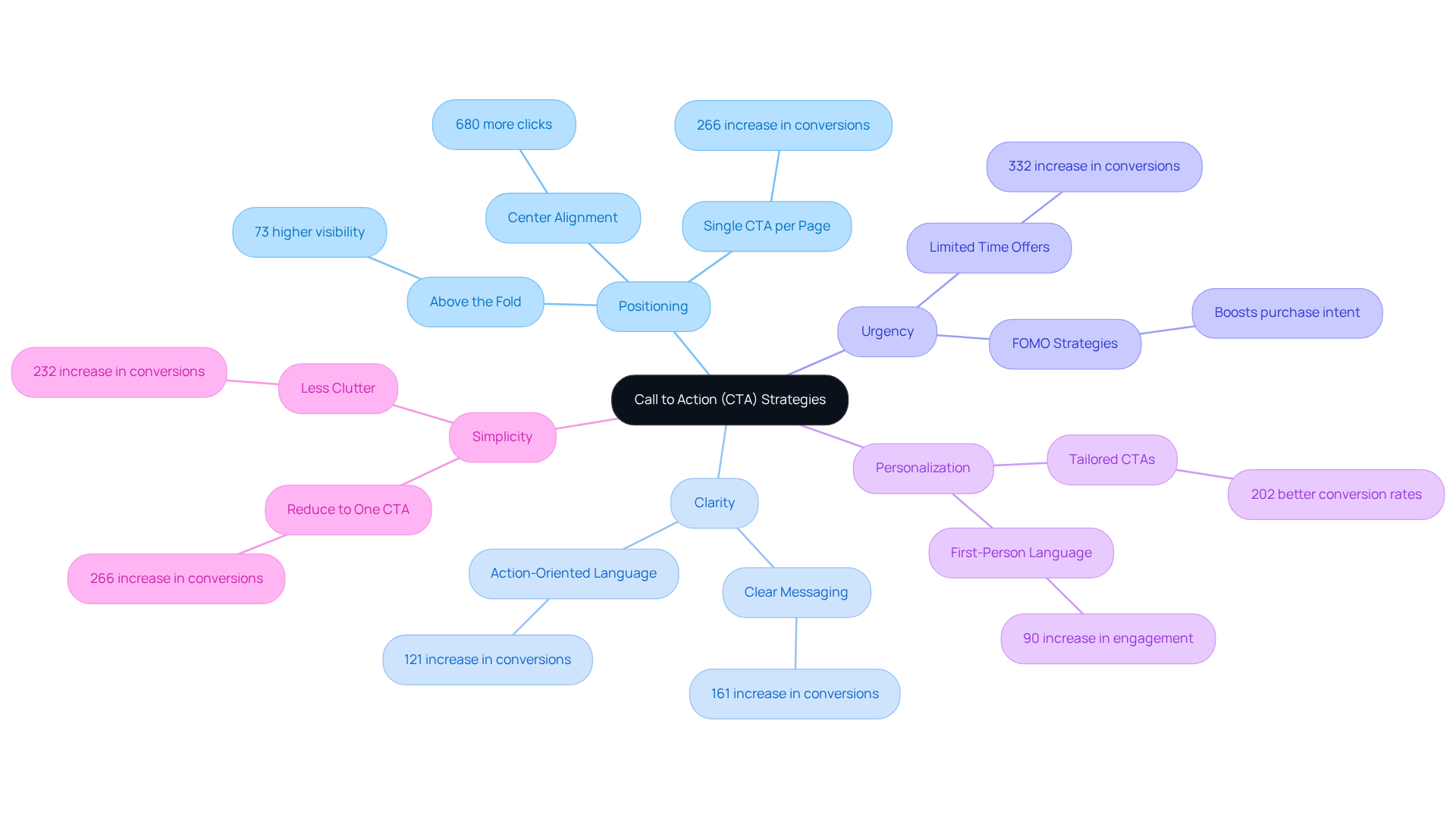
Wireframing: Planning Website Layout and Functionality
Wireframing often presents a significant challenge in the web design journey, acting as a vital visual blueprint that outlines the layout and functionality of an online platform. For technology ventures, this stage is particularly important. It allows teams to thoughtfully design the interface and user experience before diving into development. By creating wireframes, startups can uncover potential issues early on, streamline navigation, and ensure that their website meets both audience needs and business goals. This proactive approach not only enhances the overall effectiveness of the final product but also significantly boosts customer satisfaction.
Statistics reveal that effective wireframing can lead to remarkable improvements in user experience; for instance, UX design has been shown to increase conversion rates by as much as 400%. Moreover, startups that embrace wireframing often experience improved user interaction and retention, as it fosters a more intuitive layout that resonates with users. Success stories from technology firms illustrate how wireframing has played an essential role in refining online layouts and functionalities, ultimately resulting in products that are user-friendly and aligned with market demands.
Incorporating wireframing into the development process not only nurtures a clearer vision for the project but also empowers new businesses to create websites that truly stand out in a competitive landscape. This ensures that they meet the high expectations of today’s digital consumers, fostering a sense of confidence and success.
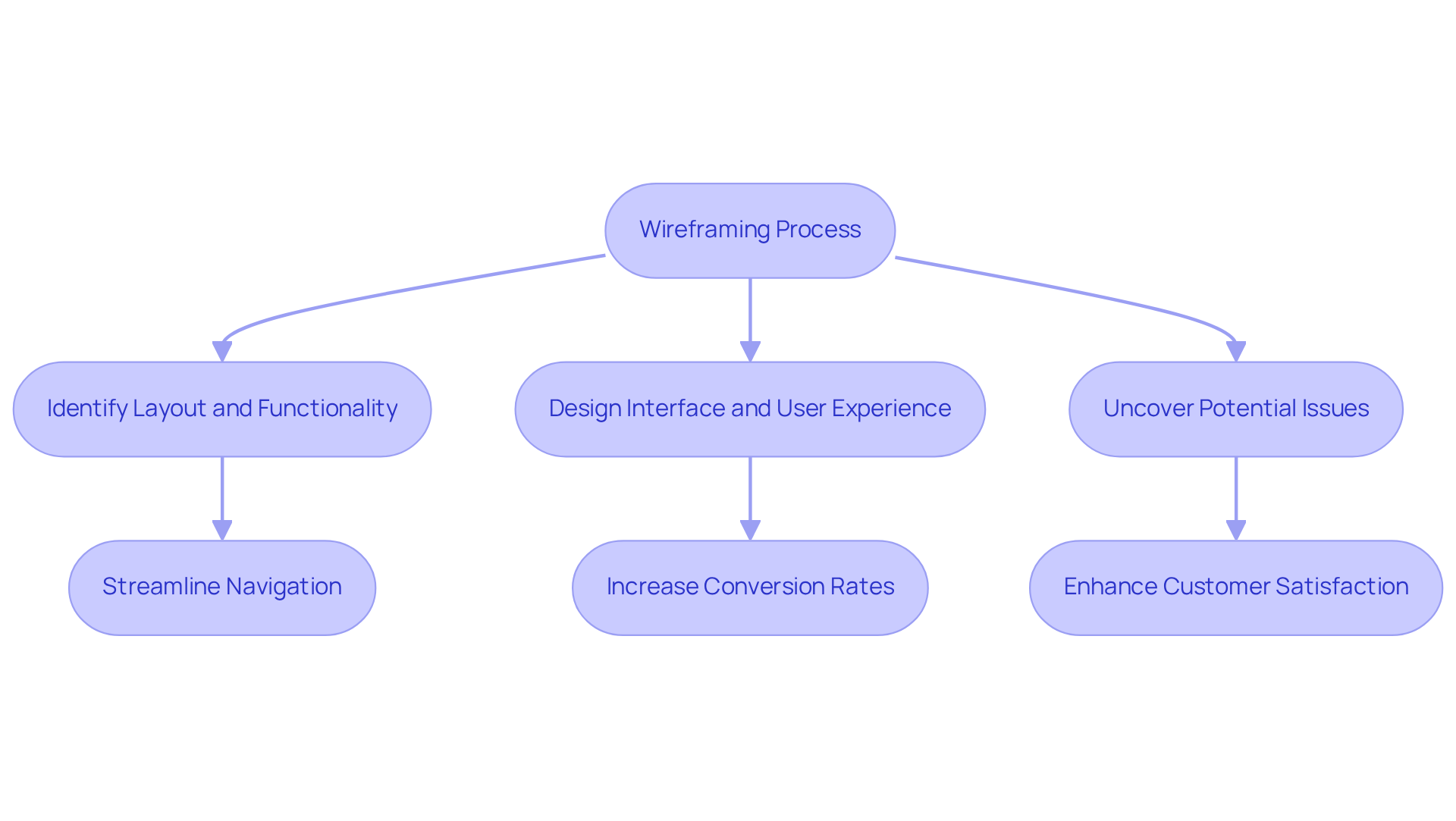
A/B Testing: Optimizing Design and Marketing Strategies
A/B testing, or split testing, presents a significant challenge for many technology companies. It can be daunting to determine which version of a webpage or marketing asset will resonate best with your audience. This data-driven approach, however, is a nurturing solution that can help you optimize design elements, content, and overall marketing strategies. By conducting A/B tests, new ventures can gain valuable insights into user behavior and preferences, empowering them to make informed choices that enhance the user experience and significantly boost conversion rates.
Consider the story of a new business that simplified its sign-up form. They experienced a remarkable increase in sign-ups, confirming the belief that a streamlined process fosters higher engagement. Similarly, Dropbox's journey with A/B testing its referral program led to substantial growth in participants, showcasing the power of data-informed decision-making in refining marketing strategies. Notably, Dropbox achieved a 10% increase in sign-up conversions by simplifying their homepage, further illustrating the transformative impact of A/B testing.
Statistics reveal that A/B testing can lead to conversion rate enhancements of up to 400%. It can also yield a 20% increase in conversion rates when optimizing landing pages, making it an essential tool for new businesses eager to improve their offerings. Moreover, 60% of firms are currently utilizing A/B testing, with many more planning to adopt this method soon, highlighting its growing significance in the digital marketing landscape.
Industry leaders emphasize the importance of A/B testing, stating, "A/B testing assists marketers in making thoughtful and meaningful adjustments to their experiences while collecting data on the results." Additionally, they note, "A/B testing provides empirical evidence," reinforcing the credibility of this approach. This iterative process not only encourages a culture of experimentation but also allows new ventures to adapt swiftly to user preferences and market trends, ultimately fostering sustainable growth.
To maximize the effectiveness of A/B testing, it is crucial for new businesses to define clear objectives before running tests. This clarity will enable them to measure success accurately and embrace the nurturing potential of A/B testing as they navigate their path toward success.

Brand Identity: Establishing a Strong Market Presence
Brand identity is more than just a logo; it encompasses the visual elements, messaging, and overall perception of a brand in the market. For technology ventures, the challenge of establishing a strong brand identity can feel daunting in a competitive landscape. This struggle often leads to feelings of uncertainty about how to stand out. However, creating a memorable logo, consistent color schemes, and a clear value proposition can make a significant difference. A well-defined brand identity fosters trust and recognition, ultimately nurturing customer loyalty and engagement.
In fact, studies show that:
- 90% of consumers believe brand loyalty is crucial to their purchasing decisions.
- 77% of marketing leaders affirm that a strong brand is critical to their growth plans, underscoring the broader significance of brand identity.
Successful examples in the technology sector, like Apple and Google, illustrate how robust brand identities can lead to sustained customer engagement and loyalty. Key elements of a strong brand identity for technology companies include:
- Authenticity
- Consistency across platforms
- A commitment to values that resonate with their target audience
It's heartening to note that 92% of marketers consider brand authenticity important. By prioritizing these aspects, new businesses can enhance their market presence and build lasting relationships with customers. To further strengthen their brand identity, new businesses should consider performing a brand audit to assess their current brand performance. This self-reflection can be a powerful step towards growth and connection with their audience.
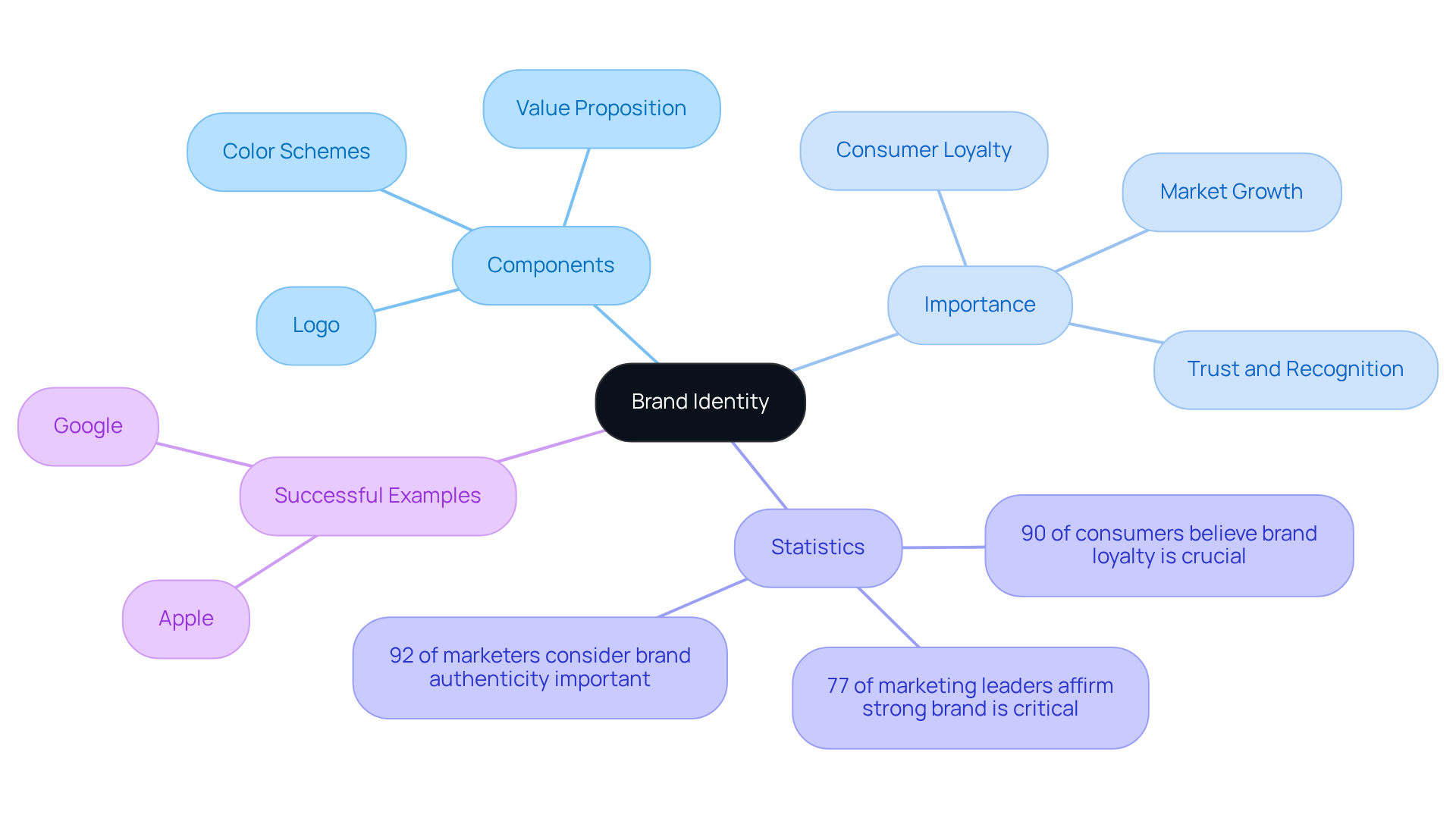
Accessibility: Ensuring Usability for All Users
Accessibility in web design is a crucial practice that ensures websites are usable for everyone, including individuals with disabilities. For technology ventures, prioritizing accessibility is not just a legal obligation in many areas; it’s a moral responsibility. By implementing accessibility best practices—like providing alternative text for images and ensuring keyboard navigation—startups can reach a broader audience and create inclusive digital experiences that truly cater to all users.
Consider this: research shows that 94.8% of the world’s top one million homepages exhibit detectable WCAG failures. This statistic highlights the widespread accessibility challenges that are often discussed in web design definitions. Companies that prioritize accessibility are four times more likely to achieve superior total shareholder returns compared to their competitors, as noted by Accenture. Furthermore, user-friendly online platforms positively impact search engine rankings, boosting visibility to potential clients. On the flip side, inaccessible online platforms can lead to significant financial losses; for instance, UK retailers lost £17.1 billion in revenue in 2019 due to accessibility issues.
Successful examples of accessibility in technology companies reveal the tangible benefits of inclusive web design definitions. Many e-commerce businesses have enhanced their online accessibility in response to legal pressures, resulting in increased customer trust and loyalty. With 70% of disabled online consumers leaving sites that are difficult to navigate, businesses that prioritize accessibility can significantly improve user retention and satisfaction.
Incorporating accessibility into the design process not only nurtures a more inclusive digital environment but also unveils a market worth $13 trillion, emphasizing the economic potential of disability inclusion. By embedding accessibility into their core strategies, tech startups can ensure compliance while positioning themselves for long-term success in our increasingly digital world.
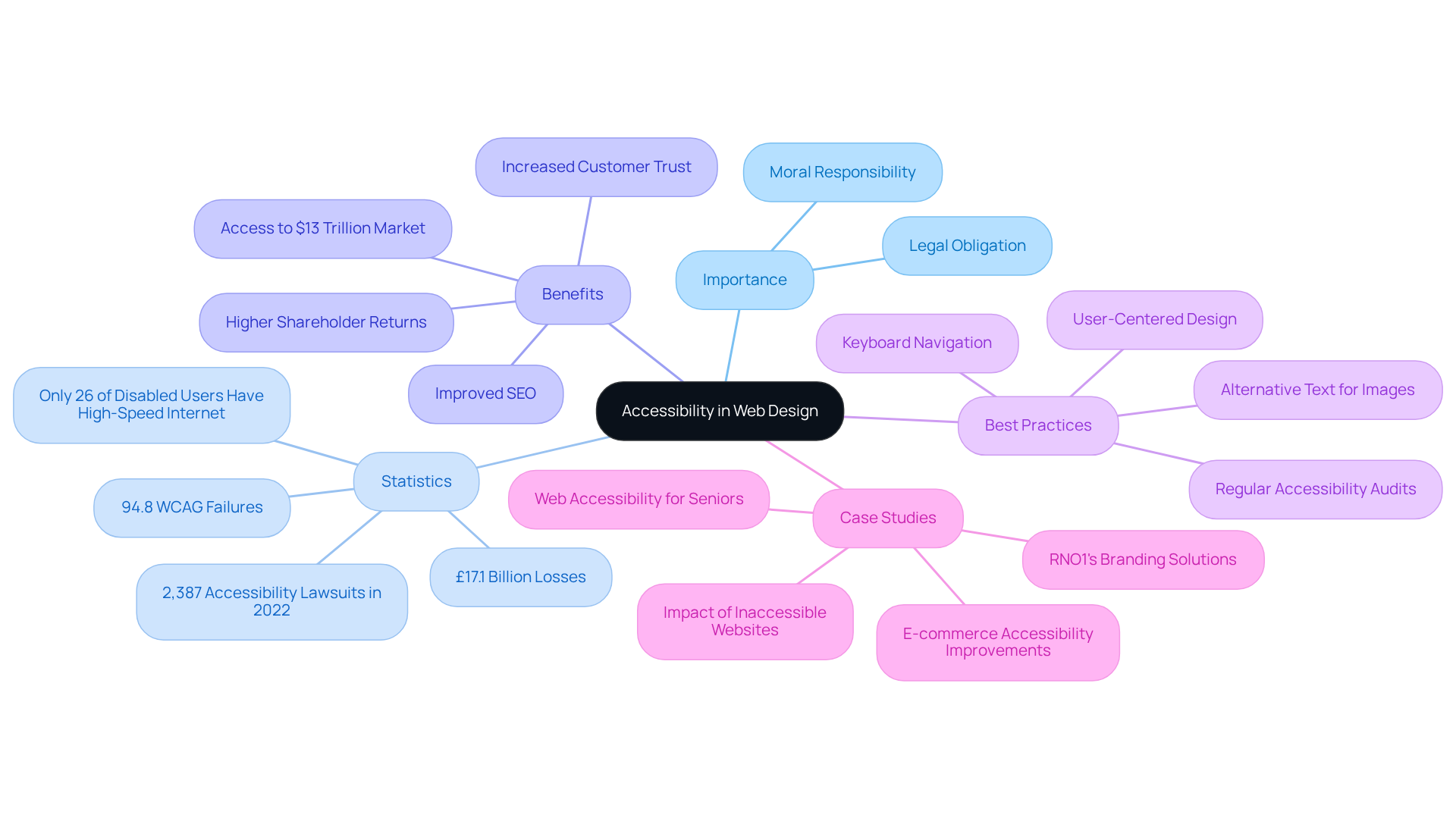
Conclusion
Establishing a strong web presence can feel daunting for tech startups navigating today’s competitive digital landscape. It’s not just about the technical aspects; understanding essential web design definitions is a strategic necessity that can profoundly influence your brand visibility, user experience, and overall business growth. By investing in effective branding, user experience, responsive design, and accessibility, you can create memorable digital experiences that truly resonate with your audience.
The insights shared here highlight the importance of various elements in web design. Consider the role of user experience (UX) in fostering customer loyalty, or the necessity of responsive design to accommodate diverse devices. A robust content management system (CMS) is invaluable for seamless content updates. Additionally, strategies like search engine optimization (SEO), effective call-to-action (CTA) placements, wireframing, and A/B testing are vital tools for enhancing user engagement and conversion rates.
Ultimately, as a tech startup, prioritizing these web design principles is crucial not only for attracting customers but also for retaining them in an increasingly digital world. By embracing these strategies, you can foster a more inclusive, user-friendly environment that drives sustainable growth and enhances brand loyalty. The journey toward a successful digital presence begins with understanding and implementing these essential web design definitions, paving the way for a thriving future in the tech industry. Remember, you’re not alone on this journey; together, we can navigate the complexities of the digital landscape.
Frequently Asked Questions
What is the importance of branding and digital design services for startups?
Branding and digital design services help startups establish a strong online presence, making them more memorable and trustworthy. Research indicates that maintaining brand consistency can make companies 3.5 times more likely to attract new customers and can lead to revenue growth of 10-20%.
How can effective branding strategies impact a startup's success?
Effective branding strategies can enhance customer loyalty and engagement, leading to significant revenue growth. For example, 68% of businesses that embrace brand consistency experience this growth, as seen in the case of Tesla.
What role does User Experience (UX) play in customer satisfaction for tech startups?
UX is crucial for enhancing customer satisfaction and loyalty. Prioritizing effective UX design can significantly improve perceptions and behaviors, leading to better customer retention and increased satisfaction.
What are some statistics related to User Experience (UX) that startups should be aware of?
Research shows that 94% of first impressions are design-related, and 88% of users are less likely to return to a website after a poor user experience. Additionally, a well-optimized UX can improve customer retention by 42% and satisfaction by 33%.
How does loading time affect user experience and conversion rates?
Mobile sites that load in two seconds or less can achieve a 15% higher conversion rate. Conversely, 53% of mobile site visitors leave if a page takes longer than three seconds to load, highlighting the urgency of optimizing loading times.
What is responsive design and why is it important for technology startups?
Responsive design ensures that a website's structure and content adapt seamlessly to various screen sizes and devices. It is important because mobile traffic constitutes a significant share of web visits, and a responsive layout can decrease bounce rates by 40% and nearly double mobile conversions.
What are the consequences of a negative user experience on a website?
A negative user experience can deter 88% of online shoppers from revisiting a site, making it crucial for startups to ensure a positive experience to retain visitors and boost conversions.
How can startups create engaging digital experiences?
By focusing on essential aspects like effective branding, optimized UX, and responsive design, startups can foster customer loyalty and drive growth, creating communities that thrive on positive interactions.




